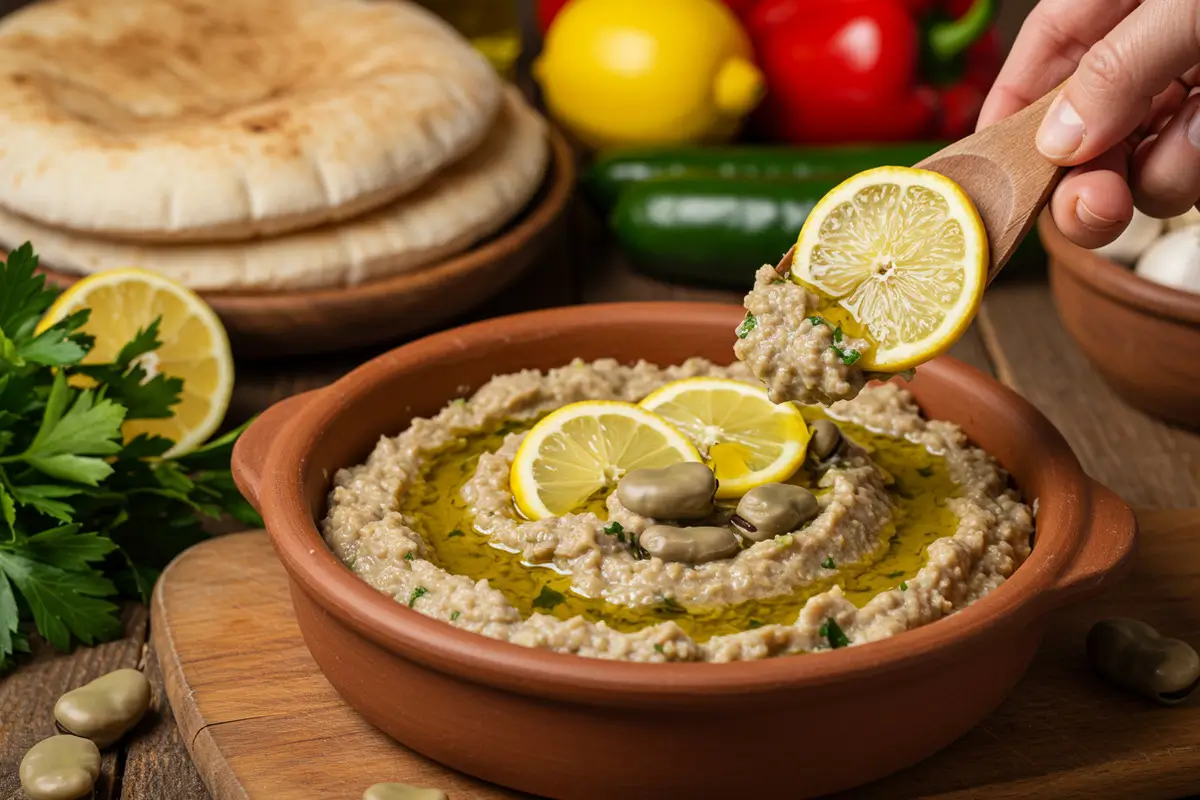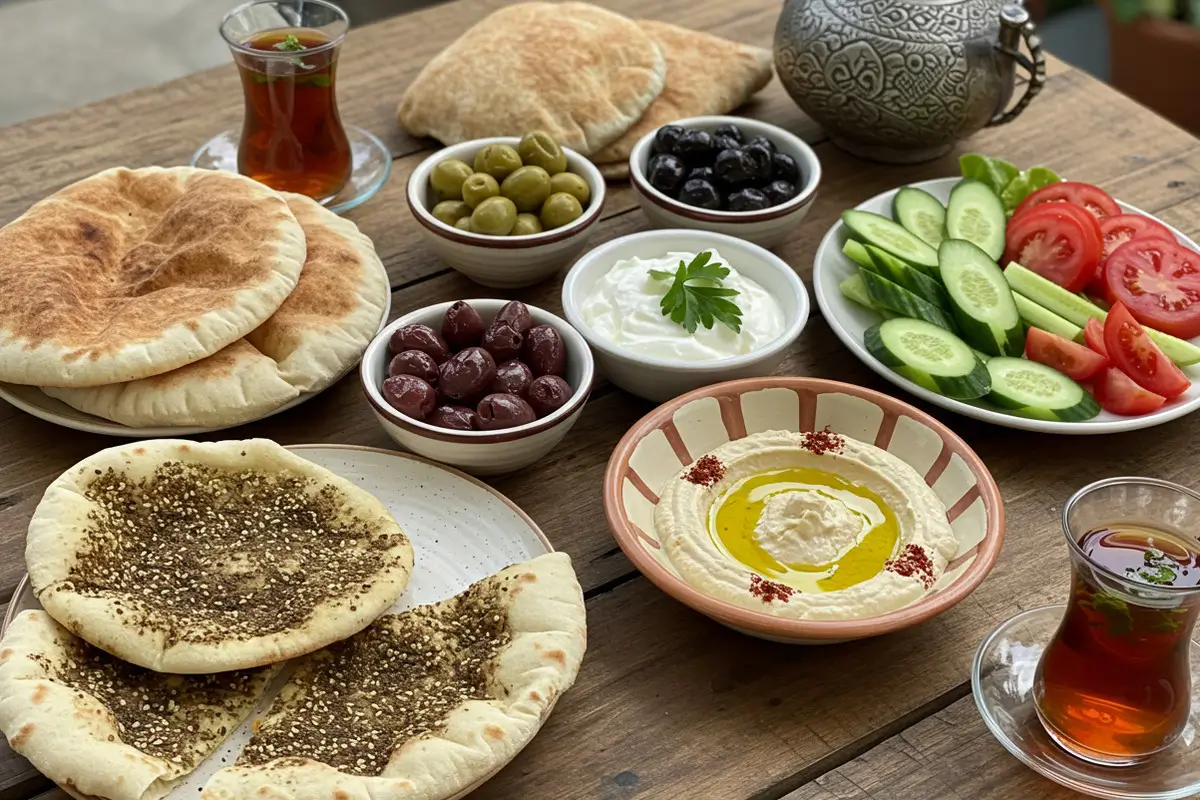1. Introduction
Breakfast is often referred to as the most important meal of the day, and in Arabic culture, it holds a special place. If you’re wondering how to eat Arabic breakfast authentically, it’s all about embracing the flavors, traditions, and sense of community that come with it. Rooted in centuries of culinary heritage, this meal combines simple yet wholesome ingredients like bread, legumes, and fresh produce, making it a delicious and fulfilling way to start your day.
Exploring Arabic breakfast goes beyond the food itself—it’s about the ritual of breaking bread, sharing stories, and enjoying a moment of togetherness. Whether you’re dining at home or in a bustling café, the meal offers a window into the rich cultural tapestry of the Middle East.
2. Understanding Arabic Breakfast
To truly appreciate Arabic breakfast, it’s essential to understand its origins and how it has evolved over centuries. This meal is deeply influenced by the region’s history, climate, and agricultural practices.
2.1. Historical Roots
Arabic breakfast traditions date back to ancient times when farmers and traders needed hearty, nutritious meals to sustain them through long hours of work. Ingredients like legumes, bread, and olive oil were staples due to their availability and high energy content.
2.2. Cultural Significance
In many Arab households, breakfast is a communal experience. It’s not uncommon to see a large family gathering around a table, sharing dishes from a central spread. This practice emphasizes the values of generosity, hospitality, and togetherness.
2.3. Variety Across Regions
While the core elements of Arabic breakfast are consistent—bread, cheese, legumes, and fresh produce—each region adds its unique touch. For example:
- Levantine breakfast (Lebanon, Syria, Jordan, and Palestine) often includes za’atar manakish and foul medames.
- Gulf countries enjoy balaleet (sweet vermicelli) and harees.
- North African breakfast features shakshuka and msemmen (layered bread).
This diversity makes Arabic breakfast a culinary adventure worth exploring.
3. Key Components of Arabic Breakfast
Arabic breakfast is a harmonious blend of simplicity and flavor, characterized by fresh ingredients and time-tested recipes. Each component of the meal complements the others, creating a balanced and satisfying dining experience. Here are the essential elements:
3.1. Bread Varieties
Bread is the cornerstone of an Arabic breakfast, used to scoop up dips, wrap ingredients, or enjoy on its own. Popular choices include:
- Pita Bread: A soft, round bread with a pocket, perfect for holding fillings.
- Saj Bread: Thin and flexible, it’s cooked on a domed griddle and often served warm.
- Manakish: A flatbread topped with za’atar, cheese, or minced meat, commonly enjoyed in the Levant.
3.2. Dairy Products
Dairy adds creaminess and tang to the meal. Key items include:
- Labneh: Strained yogurt with a thick consistency, often drizzled with olive oil.
- Feta Cheese: Salty and crumbly, it pairs well with bread and fresh vegetables.
- Halloumi: A semi-hard cheese, usually grilled or fried until golden.
3.3. Legumes
Legumes provide a hearty and protein-rich base:
- Foul Medames: A dish of slow-cooked fava beans seasoned with olive oil, garlic, and lemon juice.
- Hummus: A creamy chickpea dip flavored with tahini, garlic, and lemon.
- Falafel: Deep-fried balls made from ground chickpeas or fava beans, crispy on the outside and tender inside.
3.4. Fresh Produce
A platter of fresh vegetables is a must:
- Olives: A staple, ranging from green and brined to black and cured.
- Tomatoes and Cucumbers: Sliced or diced, these add a refreshing crunch.
- Herbs: Mint and parsley are common additions for their aromatic flavor.
3.5. Spices and Condiments
Spices elevate the flavors, and condiments tie the meal together:
- Za’atar: A mix of thyme, sesame seeds, and sumac, often sprinkled on bread.
- Olive Oil: A drizzle over dishes adds richness.
- Tahini: Sesame seed paste, served as a dip or dressing.
4. How to Prepare an Authentic Arabic Breakfast at Home
Creating an authentic Arabic breakfast at home is an enjoyable and rewarding experience. With a little planning, you can recreate the magic of this traditional meal.
4.1. Planning and Sourcing Ingredients
The first step is gathering the right ingredients. Visit local Middle Eastern grocery stores to find authentic items like za’atar, labneh, and high-quality olive oil. Fresh produce from a farmer’s market will also enhance the flavors.
4.2. Preparing Signature Dishes
Follow these simple recipes to craft key components of the meal:

- Hummus: Blend cooked chickpeas, tahini, garlic, lemon juice, and a splash of water until smooth. Garnish with olive oil and paprika.
- Foul Medames: Simmer canned or pre-cooked fava beans with garlic and cumin, then mash lightly. Serve with olive oil, lemon, and chopped parsley.
- Manakish: Spread a mixture of za’atar and olive oil over flatbread, then bake until golden.
4.3. Arranging the Spread
Presentation is key to an authentic Arabic breakfast. Arrange dishes on a large table with small bowls for dips, plates for vegetables, and a basket for bread.
5. Eating Etiquette for Arabic Breakfast
In Arabic culture, meals are not just about eating; they’re about sharing and bonding. When enjoying an Arabic breakfast:
- Share Dishes: Food is often served family-style, with everyone dipping into the same bowl or platter.
- Use Bread: Bread is commonly used to scoop up dips, replacing utensils in many cases.
- Practice Hospitality: Guests are encouraged to eat their fill, as hosts take pride in providing plentiful food.
- Be Mindful: Avoid wasting food and try a little bit of everything to show appreciation for the effort involved.
6. Health Benefits of Arabic Breakfast
Arabic breakfast is not only a treat for the taste buds but also a nutritious way to start the day. The meal’s variety and emphasis on wholesome ingredients contribute to its health benefits.
6.1. Balanced Nutrition
A traditional Arabic breakfast provides a balance of carbohydrates, proteins, and healthy fats:
- Carbohydrates: Found in bread and legumes, they provide sustained energy.
- Proteins: Legumes like hummus and foul medames, along with dairy products, help build and repair tissues.
- Healthy Fats: Olive oil, a key ingredient, is rich in monounsaturated fats, which support heart health.
6.2. Rich in Fiber and Antioxidants
- Vegetables: Fresh produce like tomatoes and cucumbers add fiber and antioxidants, which promote digestion and overall health.
- Legumes: High in dietary fiber, they help regulate blood sugar and cholesterol levels.
- Spices: Za’atar and sumac contain antioxidants that support the immune system.
6.3. Low in Processed Foods
Arabic breakfast emphasizes fresh, minimally processed ingredients, reducing the intake of added sugars and preservatives.
6.4. Supports Weight Management
The inclusion of high-fiber and high-protein foods creates a sense of satiety, preventing overeating throughout the day.
7. Popular Beverages to Pair with Arabic Breakfast
No Arabic breakfast is complete without refreshing drinks to accompany the meal. The beverages served are just as traditional and significant as the food itself.

7.1. Tea (Shai)
Tea is a staple at Arabic breakfast tables:
- Typically brewed with black tea leaves, often infused with fresh mint.
- Sweetened with sugar or honey, though some enjoy it plain.
7.2. Arabic Coffee (Qahwa)
A cultural symbol, Arabic coffee is:
- Lightly roasted and flavored with cardamom for a unique taste.
- Served in small cups, often accompanied by dates or sweets.
7.3. Fresh Juices
For a lighter option, fresh juices are popular:
- Orange Juice: Vibrant and tangy, a classic choice.
- Carrot Juice: Rich in vitamins and a unique Middle Eastern favorite.
7.4. Milk-based Drinks
Some regions incorporate laban (a yogurt drink) or milk with their breakfast, offering a creamy and cooling complement to the meal.
8. Regional Variations of Arabic Breakfast
Arabic breakfast varies across regions, reflecting the diverse culinary traditions of the Middle East and North Africa.
8.1. Levantine Breakfast
- Includes za’atar manakish, foul medames, and labneh.
- Known for its emphasis on fresh vegetables and olive oil.
8.2. Gulf Breakfast
- Dishes like balaleet (sweet vermicelli) and harees (wheat and meat porridge) are common.
- Often accompanied by strong Arabic coffee.
8.3. North African Breakfast
- Features shakshuka (poached eggs in a spiced tomato sauce) and msemmen (layered bread).
- Influenced by Berber and Mediterranean cuisines.
8.4. Maghrebi Breakfast
- Incorporates dates, nuts, and honey, reflecting the desert climate’s agricultural produce.
9. Dining Out: Experiencing Arabic Breakfast in Restaurants
Enjoying an Arabic breakfast at a restaurant offers a different experience:
- Menu Highlights: Look for dishes like foul medames, freshly baked bread, and a variety of mezze.
- Atmosphere: Many eateries provide a cozy, communal setting reminiscent of traditional family gatherings.
- Recommendations: Seek out local reviews or ask for suggestions to find authentic spots.
10. Special Occasions and Breakfast Traditions
Arabic breakfast takes on a more festive role during holidays and family gatherings, often becoming a centerpiece for celebration and bonding.
10.1. Eid Breakfast
- After the morning prayers of Eid al-Fitr or Eid al-Adha, families gather to share a lavish breakfast.
- Special dishes like ma’amoul (date-filled cookies) and kunafa (a sweet cheese pastry) are added to the spread.
10.2. Weekend Family Breakfasts
- Weekends in many Arab households are dedicated to large family breakfasts.
- Extended family members join to enjoy traditional meals, creating a lively and joyful atmosphere.
10.3. Weddings and Celebrations
- In some regions, breakfast feasts are served during weddings or engagement ceremonies, showcasing the family’s hospitality.
- The menu may include unique dishes or luxurious touches like honey-drizzled desserts.
11. Modern Twists on Arabic Breakfast
As culinary trends evolve, Arabic breakfast has been reimagined to suit contemporary tastes while preserving its traditional roots.
11.1. Fusion Dishes
- Avocado Manakish: Traditional manakish topped with smashed avocado and za’atar.
- Falafel Waffles: Falafel batter cooked in a waffle iron for a fun twist.
- Labneh Cheesecake: A creative dessert using labneh as a creamy base.
11.2. Health-conscious Adaptations
- Replacing white bread with whole grain or gluten-free alternatives.
- Using air fryers to prepare healthier versions of falafel and other fried items.
11.3. Global Influence
- Incorporating international flavors, like spreading hummus on toast or pairing labneh with smoked salmon, has made Arabic breakfast more accessible to a global audience.
12. FAQs
12.1. What is a typical Arabic breakfast?
A typical Arabic breakfast consists of bread (like pita or manakish), dairy products (labneh, feta), legumes (foul medames, hummus), fresh vegetables, olives, and condiments like za’atar and olive oil.
12.2. How to eat breakfast properly?
To fully enjoy an Arabic breakfast:
- Use bread to scoop up dips and spreads.
- Combine flavors from different dishes, like labneh with olives or za’atar with olive oil.
- Share the meal with others, as it’s meant to be a communal experience.
12.3. What do Muslims eat for breakfast?
Muslims often eat traditional Arabic breakfast items such as foul medames, hummus, and bread. During Ramadan, suhoor (the pre-dawn meal) may include these along with energy-boosting items like dates and laban.
12.4. What do Arabs drink for breakfast?
Popular drinks include:
- Tea (shai): Often with mint or sweetened with sugar.
- Arabic coffee (qahwa): Lightly roasted and infused with cardamom.
- Fresh juices: Orange or carrot juice is commonly served.
Conclusion
Arabic breakfast is more than just a meal; it’s a celebration of culture, community, and culinary artistry. From the comforting flavors of za’atar to the refreshing crunch of cucumbers, every component tells a story of heritage and tradition. Whether you’re dining with family, exploring regional variations, or recreating dishes at home, embracing Arabic breakfast offers a taste of the Middle East’s rich cultural tapestry.
More Delicious Recipes
- What is a Traditional Arab Breakfast?
Are Eggs and Ground Beef Good Together?10 Reasons Why
Can You Make Breakfast Sliders the Night Before? Ultimate Guide to Meal Prep

